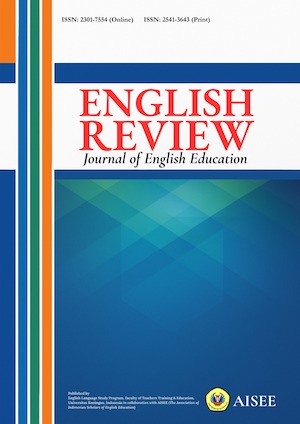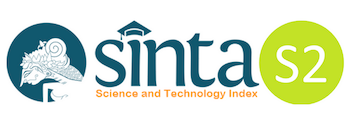SEMIOTIC ANALYSIS OF COVID-19 MEME IN SOCIAL MEDIA
Abstract
The presence of social media makes the process of social interaction experience very significant changes. Communication through social media is a very important social interaction in human life. Along with the increasing use of social media, it has spawned new phenomena among social media users, one of which is creativity in making memes. Memes can be in the form of text or images that contain issues and events in a style that intrigues and are widely discussed because they spread and comment so quickly on social media. The purpose of this study was to describe the signifier and signified in the Covid-19 meme and explain the meaning contained in the Covid-19 meme. The Covid-19 meme itself is one of the memes found on social media. The approach used in this research was a qualitative approach which produces descriptive analysis. The researcher seeked the facts behind the creation of the Covid-19 meme circulating on social media. The signifiers found in the Covid-19 meme include snippets of famous movie and game scenes. The insinuations in the sentences are also reality. The sentences provide a statement that contains information and expression of the feelings of the creator as a fighter in the pandemic season.
References
Aiello, G. (2020). Visual semiotics: Key concepts and new directions. The SAGE Handbook of Visual Research Methods, 367–380.
Anderson, M., & Jiang, J. (2018). Teens, social media & technology 2018. Pew Research Center, 31(2018), 1673–1689.
Barbosa, T. R., & Sales, L. S. (2022). Poetry in digital times: A didactic proposal for the use of instapoetry in the EFL context. International Journal of English Linguistics, 12(4).
Bauer, J. C., & Ngondo, P. S. (2022). Moms, memes, and mitigating pandemic stress: exploring themes and implications in an academic mamas’ Facebook group. Women’s Studies in Communication, 45(1), 45–69.
Compagno, D. (2018). Quantitative semiotic analysis. Springer.
Crow, D. (2022). Visible signs: An introduction to semiotics in the visual arts. Bloomsbury Publishing.
De Leon, F. M. G., & Ballesteros-Lintao, R. (2021). The rise of meme culture: Internet political memes as tools for analysing Philippine propaganda. Journal of Critical Studies in Language and Literature, 2(4), 1–13.
Harshavardhan, V., Wilson, D., & Kumar, M. V. (2019). Humour discourse in internet memes: An aid in ESL classrooms. Asia Pacific Media Educator, 29(1), 41–53.
Hussain, S. M. S., Tak, A., Ustun, T. S., & Ali, I. (2018). Communication modeling of solar home system and smart meter in smart grids. IEEE Access, 6, 16985–16996.
Ibrahim, I., & Sulaiman, S. (2020). Semiotic communication: An approach of understanding a meaning in communication. International Journal of Media and Communication Research (IJMCR), 1(1), 22–31.
Junawan, H., & Laugu, N. (2020). Eksistensi media sosial, Youtube, Instagram dan WhatsApp ditengah pandemi covid-19 dikalangan masyarakat virtual Indonesia. Baitul’Ulum: Jurnal Ilmu Perpustakaan Dan Informasi, 41–57.
Kamil., Isnawan, L., Sukma, H., Rahma, F., Sartika, D., Muliati., Zulkarnaen, D., Octavia, D., Selvi, L. K., Sahirah., Dewintara, E., Muchtar., Fatimah, S. N., Hariyanto., Hasyim, M., Putri, N. M. N. F., Hafsah., Aeni, N., Nurwina., Samad, K., & Sari, N. I. (2020). Bersama melawan covid 19. IAIN Parepare Nusantara Press.
Leone, M., Mari-Liis, M., & Andreas, V. (2020). Semiotic approaches to conspiracy theories. In The Routledge Handbook of Conspiracy Studies (pp. 43–55). Routledge.
Mikhaeil, C. A., & Baskerville, R. L. (2019). Using semiotics to analyze representational complexity in social media. Information and Organization, 29(4), 100271. https://doi.org/https://doi.org/10.1016/j.infoandorg.2019.100271
Milner, R. M. (2018). The world made meme: Public conversations and participatory media. Mit Press.
Moleong, L. J. (2017). Metode penelitian kualitatif. Remaja Rosdakarya.
Myrick, J. G., Nabi, R. L., & Eng, N. J. (2022). Consuming memes during the covid pandemic: effects of memes and meme type on covid-related stress and coping efficacy. Psychology of Popular Media, 11(3), 316–323. https://doi.org/10.1037/ppm0000371
Osterroth, A. (2020). Internet-memes als multimodale Sprechakte in öffentlichen Diskursen anhand von Beispielen aus Antwortthreads von real Donald Trump. Linguistik Online, 101(1), 115–137.
Owen, B., & Zatori, A. (2021). The rise of meme tourism: Tourism transformations towards ‘fifteen minutes of fame.’ In Emerging Transformations in Tourism and Hospitality (pp. 127–141). Routledge.
Pandey, P., & Pandey, M. M. (2021). Research methodology tools and techniques. Bridge Center.
Porubay, I. F., & Sotvaldieva, H. M. (2022). The functions of memes in contemporary internet discourse. Barqarorlik va yetakchi tadqiqotlar onlayn ilmiy jurnali, 2(11), 171–181.
Sinuraya, J. S. B., Azhar, A. A., & Sazali, H. (2022). Analysis of semiotics representation of feminism in the Mulan film 2020. International Journal of Cultural and Social Science, 3(1), 94–105.
Siregar, I. (2022a). Semiotic touch in interpreting poetry. Britain International of Linguistics, Arts, and Education Sciences Journal, 4(1), 19–27. https://doi.org/https://doi.org/10.33258/biolae.v4i1.618
Siregar, I. (2022b). Semiotics analysis in the Betawi traditional wedding "Palang Pintu": The study of semiotics Roland Barthes. International Journal of Linguistics Studies, 2(1), 1–7.
Surya, R. D. (2019). “Meme” sebagai sebuah pesan dan bentuk hiperrealitas di media sosial. Mediakom : Jurnal Ilmu Komunikasi, 1(1), 1-8.
Torres-Marín, J., Navarro-Carrillo, G., Eid, M., & Carretero-Dios, H. (2022). Humor styles, perceived threat, funniness of COVID-19 memes, and affective mood in the early stages of COVID-19 lockdown. Journal of Happiness Studies, 23(6), 2541–2561.
Valenzuela, C. L., & Batinga, E. M. (2021). Memeiology: A content analysis on the viral covid-19 memes. Available at SSRN 4166456.
Van Wolde, E. (2018). A semiotic analysis of Genesis 2-3: a semiotic theory and method of analysis applied to the story of the Garden of Eden. Brill.
Widiastuti, A., Ismail, M. R., & Iswanto, A. Z. (2020). Analisis semiotika meme ‘profesi yang tidak dapat work from home’selama pandemi covid-19. Semiotika: Jurnal Komunikasi, 14(1), 1-7.
Woods, H. S., & Hahner, L. A. (2019). Make America meme again: The rhetoric of the Alt-right. Peter Lang New York.
All articles published in English Review: Journal of English Education (ERJEE) are licensed under the Creative Commons Attribution 4.0 International License (CC BY 4.0).
Copyright Ownership
Authors retain the copyright of their articles and grant ERJEE the right of first publication. The journal is granted a non-exclusive license to publish, reproduce, and distribute the article in any format, medium, or platform, provided that proper credit is given to the original authors.
License Terms – CC BY 4.0
Under the Creative Commons Attribution 4.0 International License, others are free to:
- Share — copy and redistribute the material in any medium or format
- Adapt — remix, transform, and build upon the material for any purpose, even commercially
As long as they:
- Provide appropriate credit to the original author(s) and source
- Provide a link to the license (https://creativecommons.org/licenses/by/4.0/)
- Indicate if any changes were made
There are no restrictions on the reuse, reproduction, or adaptation of published articles as long as attribution is properly given.
Author Warranties
By submitting a manuscript to ERJEE, authors confirm that:
- The work is original and does not infringe any existing copyright.
- The manuscript has not been previously published and is not under consideration elsewhere.
- All sources and references are appropriately acknowledged.
- Necessary permissions have been obtained for any copyrighted materials used.









